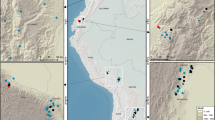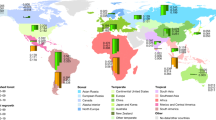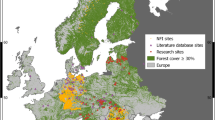Abstract
Old-growth forests remove carbon dioxide from the atmosphere1,2 at rates that vary with climate and nitrogen deposition3. The sequestered carbon dioxide is stored in live woody tissues and slowly decomposing organic matter in litter and soil4. Old-growth forests therefore serve as a global carbon dioxide sink, but they are not protected by international treaties, because it is generally thought that ageing forests cease to accumulate carbon5,6. Here we report a search of literature and databases for forest carbon-flux estimates. We find that in forests between 15 and 800 years of age, net ecosystem productivity (the net carbon balance of the forest including soils) is usually positive. Our results demonstrate that old-growth forests can continue to accumulate carbon, contrary to the long-standing view that they are carbon neutral. Over 30 per cent of the global forest area is unmanaged primary forest, and this area contains the remaining old-growth forests7. Half of the primary forests (6 × 108 hectares) are located in the boreal and temperate regions of the Northern Hemisphere. On the basis of our analysis, these forests alone sequester about 1.3 ± 0.5 gigatonnes of carbon per year. Thus, our findings suggest that 15 per cent of the global forest area, which is currently not considered when offsetting increasing atmospheric carbon dioxide concentrations, provides at least 10 per cent of the global net ecosystem productivity8. Old-growth forests accumulate carbon for centuries and contain large quantities of it. We expect, however, that much of this carbon, even soil carbon9, will move back to the atmosphere if these forests are disturbed.
This is a preview of subscription content, access via your institution
Access options
Subscribe to this journal
Receive 51 print issues and online access
$199.00 per year
only $3.90 per issue
Buy this article
- Purchase on SpringerLink
- Instant access to full article PDF
Prices may be subject to local taxes which are calculated during checkout


Similar content being viewed by others
References
Carey, E. V., Sala, A., Keane, R. & Callaway, R. M. Are old forests underestimated as global carbon sinks? Glob. Change Biol. 7, 339–344 (2001)
Pregitzer, K. S. & Euskirchen, E. S. Carbon cycling and storage in world forests: biome patterns related to forest age. Glob. Change Biol. 10, 2052–2077 (2004)
Magnani, F. et al. The human footprint in the carbon cycle of temperate and boreal forests. Nature 447, 848–850 (2007)
Zhou, G. Y. et al. Old-growth forests can accumulate carbon in soils. Science 314, 1417 (2006)
Kira, T. & Sihdei, T. Primary production and turnover of organic matter in different forest ecosystems of the western pacific. Jpn. J. Ecol. 17, 70–87 (1967)
Odum, E. P. The strategy of ecosystem development. Science 164, 262–270 (1969)
FAO. Global Forest Resources Assessment 2005. Progress towards sustainable forest management. Forestry Paper 147 (Food and Agriculture Organization of the United Nations, 2006)
Bolin, B. et al. in IPCC, Land Use, Land-Use Change, and Forestry. A Special Report of the IPCC (eds Watson, R. T. et al.) 23–51 (Cambridge Univ. Press, 2000)
Fontaine, S. et al. Stability of organic carbon in deep soil layers controlled by fresh carbon supply. Nature 450, 277–280 (2007)
Acker, S. A., Halpern, C. B., Harmon, M. E. & Dyrness, C. T. Trends in bole biomass accumulation, net primary production and tree mortality in Pseudotsuga menziesii forests of contrasting age. Tree Physiol. 22, 213–217 (2002)
Knohl, A., Schulze, E. D., Kolle, O. & Buchmann, N. Large carbon uptake by an unmanaged 250-year-old deciduous forest in Central Germany. Agric. For. Meteorol. 118, 151–167 (2003)
Law, B. E. et al. Changes in carbon storage and fluxes in a chronosequence of ponderosa pine. Glob. Change Biol. 9, 510–524 (2003)
Desai, A. R. et al. Comparing net ecosystem exchange of carbon dioxide between an old-growth and mature forest in the upper Midwest, USA. Agric. For. Meteorol. 128, 33–55 (2005)
Gower, S. T., McMurtrie, R. E. & Murty, D. Aboveground net primary production decline with stand age: Potential causes. Trends Ecol. Evol. 11, 378–382 (1996)
Binkley, D. et al. Age-related decline in forest ecosystem growth: an individual-tree, stand-structure hypothesis. Ecosystems 5, 58–67 (2002)
Van Tuyl, S., Law, B. E., Turner, D. P. & Gitelman, A. I. Variability in net primary production and carbon storage in biomass across Oregon forests—an assessment integrating data from forest inventories, intensive sites, and remote sensing. For. Ecol. Manage. 209, 273–291 (2005)
Harmon, M. E., Ferrell, W. K. & Franklin, J. F. Effects on carbon storage of conversion of old-growth forests to young forests. Science 247, 699–702 (1990)
Janish, J. E. & Harmon, M. E. Successional changes in live and dead wood carbon stores: implications for net ecosystem productivity. Tree Physiol. 22, 77–89 (2002)
Wirth, C., Czimczik, C. I. & Schulze, E. D. Beyond annual budgets: carbon flux at different temporal scales in fire-prone Siberian Scots pine forests. Tellus 54, 611–630 (2002)
Knohl, A. et al. Carbon dioxide exchange of a Russian boreal forest after disturbance by wind throw. Glob. Change Biol. 8, 231–246 (2002)
Kowalski, A. S. et al. Paired comparisons of carbon exchange between undisturbed and regenerating stands in four managed forests in Europe. Glob. Change Biol. 10, 1707–1723 (2004)
Irvine, J., Law, B. E. & Hibbard, K. A. Postfire carbon pools and fluxes in semiarid ponderosa pine in Central Oregon. Glob. Change Biol. 13, 1748–1760 (2007)
Yoda, K., Kira, T., Ogawa, H. & Hozumi, K. Self-thinning in overcrowded pure stands under cultivated and natural conditions. J. Biol. Osaka City Univ. 14, 107–132 (1963)
Mladenoff, D. J., White, M. A., Pastor, J. & Crow, T. R. Comparing spatial pattern in unaltered old-growth and disturbed forest landscapes. Ecol. Appl. 3, 294–306 (1993)
Chapin, F. S. et al. Reconciling carbon-cycle concepts, terminology and methodology. Ecosystems 9, 1041–1050 (2005)
Ciais, P. et al. in The Carbon Balance of Forest Biomes (eds Griffith, H. & Jarvis, P.) 109–150 (Taylor and Francis, 2005)
Jomura, M. et al. The carbon budget of coarse woody debris in a temperate broad-leaved secondary forest in Japan. Tellus B 59, 211–222 (2007)
Preston, C. M. & Schmidt, M. W. I. Black (pyrogenic) carbon: a synthesis of current knowledge and uncertainties with special consideration of boreal regions. Biogeosciences 3, 397–420 (2006)
Luyssaert, S. et al. CO2-balance of boreal, temperate and tropical forest derived from a global database. Glob. Change Biol. 13, 2509–2537 (2007)
Acknowledgements
We thank all site investigators, their funding agencies and the various regional flux networks (Afriflux, AmeriFlux, AsiaFlux, CarboAfrica, CarboEuropeIP, ChinaFlux, Fluxnet-Canada, KoFlux, LBA, NECC, OzFlux, TCOS-Siberia and USCCC), and the Fluxnet project, whose support was essential for obtaining our measurements. S.L. was supported by CoE ECO UA-Methusalem and the Research Foundation - Flanders (FWO-Vlaanderen) with a post-doctoral fellowship and a research grant. A.K. was supported by the European Union with a Marie Curie fellowship, and B.E.L. was supported by the regional North American Carbon Program project ORCA (US Department of Energy, Terrestrial Carbon Program, award number DE-FG02-04ER63917). E.-D.S. was supported by DFG-Exploratories. Additional funding for this study was received from CarboEuropeIP (project number GOCE-CT-2003-505572) and Ameriflux.
Author Contributions S.L., B.E.L., A.K. and P.C. compiled the data set. S.L., A.B. and D.H wrote code and analysed the data. S.L., E.-D.S., A.K., B.E.L., P.C. and J.G. designed the analyses and wrote the manuscript.
Author information
Authors and Affiliations
Corresponding author
Supplementary information
Supplementary Information
This file contains Supplementary Methods, Supplementary References and Supplementary Figures S1-S5 (PDF 442 kb)
PowerPoint slides
Rights and permissions
About this article
Cite this article
Luyssaert, S., Schulze, ED., Börner, A. et al. Old-growth forests as global carbon sinks. Nature 455, 213–215 (2008). https://doi.org/10.1038/nature07276
Received:
Accepted:
Issue Date:
DOI: https://doi.org/10.1038/nature07276
This article is cited by
-
Forest carbon tax and reward: regulating greenhouse gas emissions from industrial logging and deforestation in the US
Environment, Development and Sustainability (2024)
-
The potential for an old-growth forest to store carbon in the topsoil: A case study at Sasso Fratino, Italy
Journal of Forestry Research (2024)
-
Cost-effective biodiversity protection through multiuse-conservation landscapes
Landscape Ecology (2024)
-
Spatiotemporal analysis of national carbon emission and regional carbon simulation in China
Environmental Science and Pollution Research (2024)
-
Nutrient utilization strategies and age-related changes in Larix principis-rupprechtii forests
Plant and Soil (2024)



